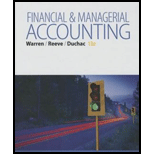
(a)
Accounts receivable turnover is a liquidity measure of accounts receivable in times, which is calculated by dividing the net credit sales by the average amount of net accounts receivables. In simple, it indicates the number of times the average amount of net accounts receivables has been collected during a particular period.
Average collection period:
Average collection period indicates the number of days taken by a business to collect its outstanding amount of accounts receivable on an average.
To calculate: The average accounts receivable turnover of Company H and Incorporation L.
(b)
To identify: Whether Company H or Incorporation L has the higher average accounts receivable turnover ratio.
(c)
To explain: The reason for the difference in average accounts receivable turnover ratio between Company H and Incorporation L.
Want to see the full answer?
Check out a sample textbook solution
Chapter 8 Solutions
Bundle: Financial & Managerial Accounting, 13th + CengageNOWv2, 2 terms (12 months) Printed Access Card
- Please provide the accurate answer to this general accounting problem using valid techniques.arrow_forwardPlease provide the accurate answer to this financial accounting problem using valid techniques.arrow_forwardI am searching for a clear explanation of this financial accounting problem with valid methods.arrow_forward
- Principles of Accounting Volume 1AccountingISBN:9781947172685Author:OpenStaxPublisher:OpenStax College
 Managerial Accounting: The Cornerstone of Busines...AccountingISBN:9781337115773Author:Maryanne M. Mowen, Don R. Hansen, Dan L. HeitgerPublisher:Cengage Learning
Managerial Accounting: The Cornerstone of Busines...AccountingISBN:9781337115773Author:Maryanne M. Mowen, Don R. Hansen, Dan L. HeitgerPublisher:Cengage Learning College Accounting, Chapters 1-27 (New in Account...AccountingISBN:9781305666160Author:James A. Heintz, Robert W. ParryPublisher:Cengage Learning
College Accounting, Chapters 1-27 (New in Account...AccountingISBN:9781305666160Author:James A. Heintz, Robert W. ParryPublisher:Cengage Learning


